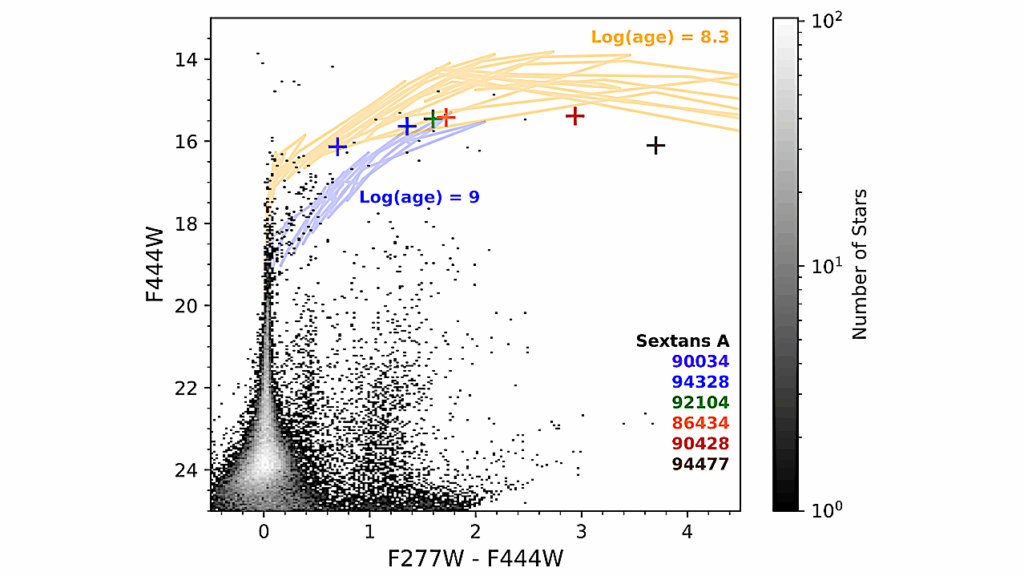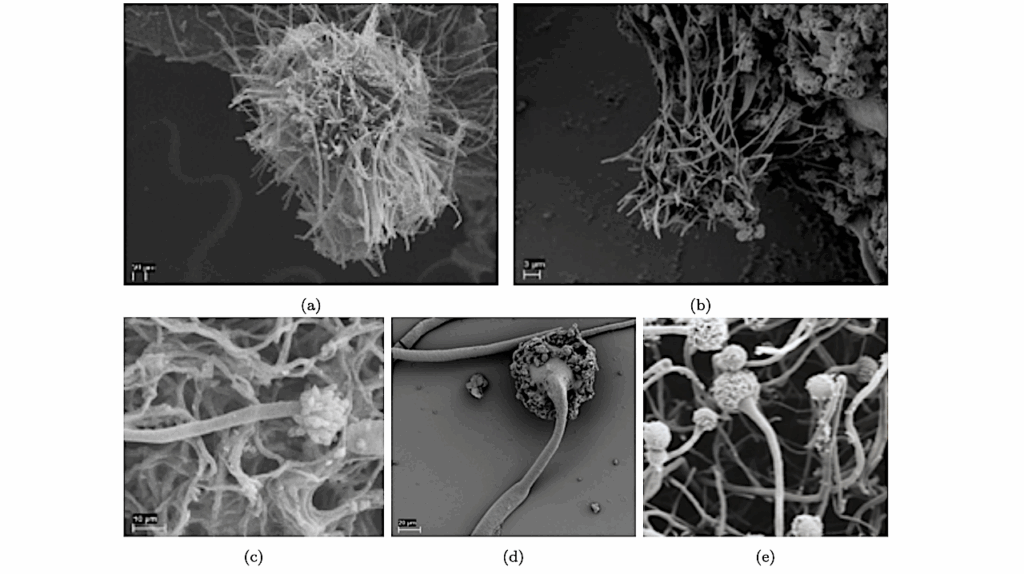Microfossil Qingjiangonema Sheds Light Evolution Of Sulfate-reducing Bacteria In Response To Oxygenation
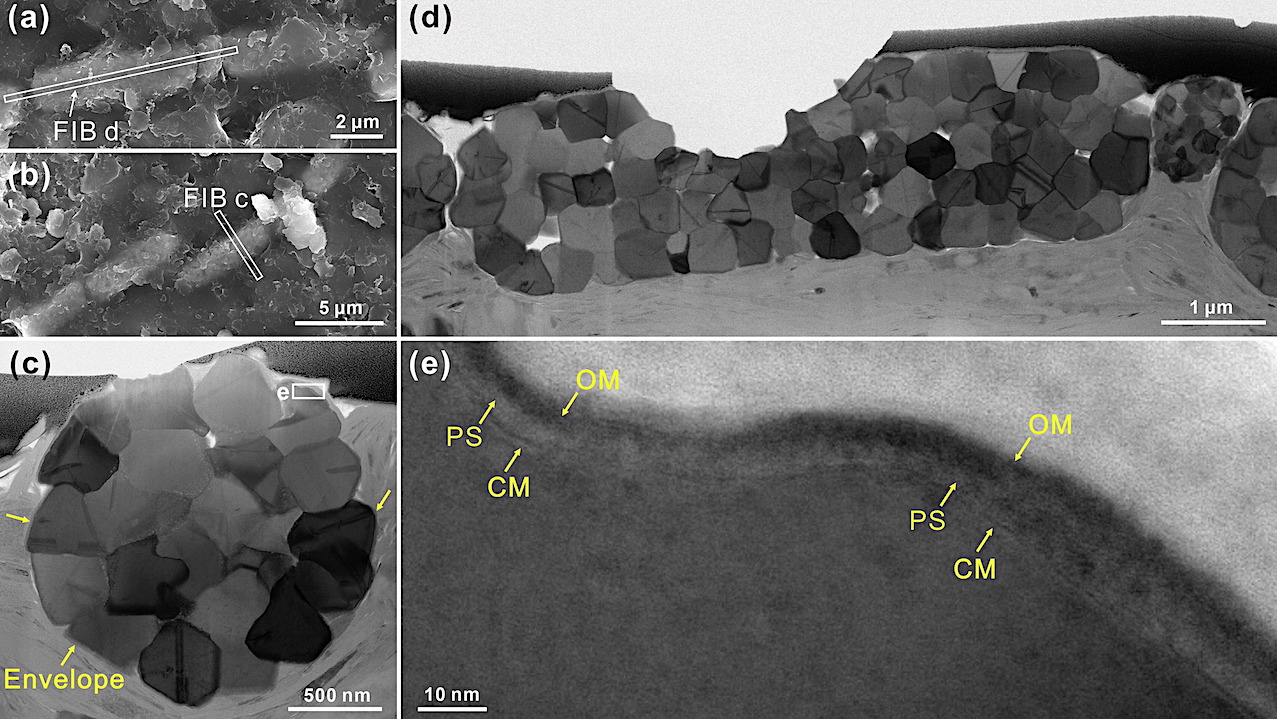
Microbial sulfate reduction dating back to the Paleoarchean plays a crucial role in driving global carbon and sulfur cycles in ancient and modern Earth.
Over 150 species of sulfate reducers from bacterial and archaeal phyla have been identified across a range of different environments. However, their origin is elusive and unequivocal fossils are lacking. Recently, a 518-million-year-old microbial fossil from China identified as an ancient sulfate-reducing bacterium sheds light on the adaptive evolution of sulfate-reducing bacteria in response to Earth’s oxygenation events.
This new fossil, named as Qingjiangonema cambria, is reported by a research team led by Prof. Xingliang Zhang from the Shaanxi Key Laboratory of Early Life and Environments at Northwest University, Prof. Jinhua Li from the Institute of Geology and Geophysics of the Chinese Academy of Sciences (IGGCAS) and Prof. Yinzhao Wang from the School of Life Sciences and Biotechnology at Shanghai Jiao Tong University.
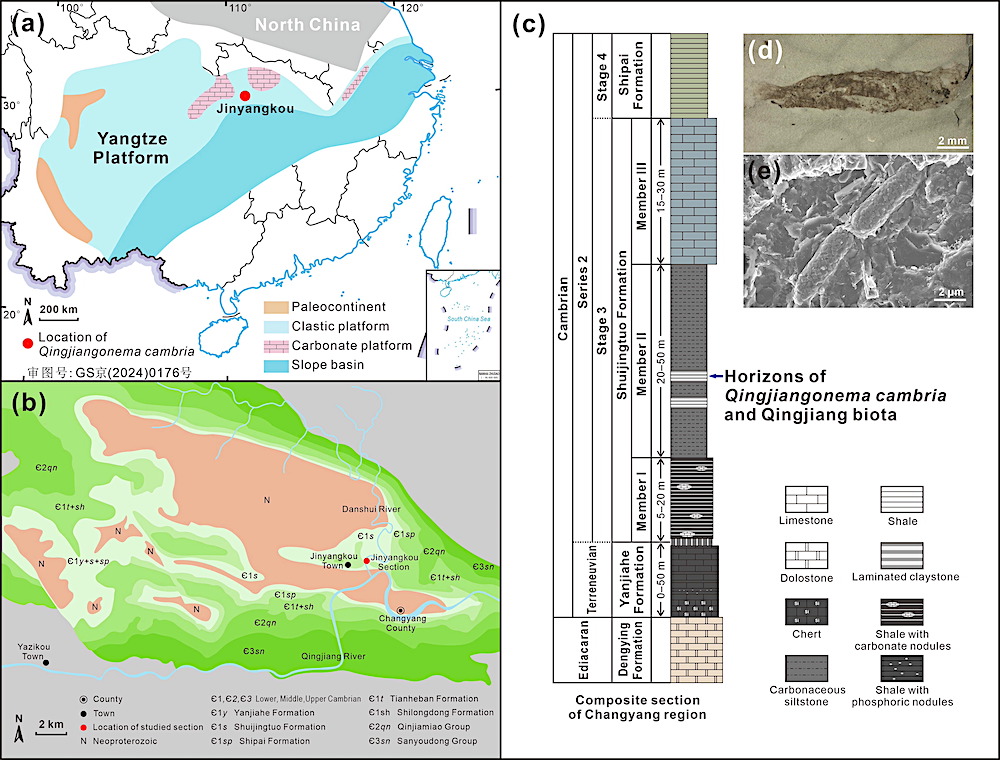
Geological map and stratigraphical column of the study area. (a) Lithofacies map of the Yangtze Platform during Cambrian Age 3 (∼521.0–514.5 Ma), indicating the location of the sampled section. (b) Geological map of the study area, showing the distribution of Cambrian outcrops and the section location. (c) Composite stratigraphical column of the Changyang area, showing the fossil-bearing horizon. (d) Soft-bodied fossil hosting Qingjiangonema cambria (e). — Science Bulletin
Qingjiangonema was discovered in black shales of the Shuijingtuo Formation that yields the Qingjiang biota, an early Cambrian Burgess Shale–type (BST) fossil Lagerstätte of South China. And it appears as a long filament comprising hundreds of rod-shaped cells. Cells are constricted at junctions, ∼1 to 3 μm wide and ∼0.8 to 11.0 μm long. Each cell is externally enveloped by a trilaminar ultrathin film and internally filled by equimorphic and equidimensional pyrite microcrystals.
The unique chain-like morphology and its presence in black shales (cemented anoxic mud), provide crucial clues to determine the biological affinity of Qingjiangonema. The faithful replication of cell morphology by pyrite microcrystals infilling suggests that Qingjiangonema be able to precipitate minerals intracellularly when it was alive.
To further determine the physiology of Qingjiangonema, in situ sulfur isotope analyses of intracellular pyrite microcrystals using Secondary Ion Mass Spectroscopy (SIMS) were carried out, and the result shows the intracellular pyrite microcrystals have a light sulfur isotope composition and large isotopic fractionation which are comparable to that of the modern Desulfonema in anoxic mud.
Interestingly, among the vast array of modern sulfate-reducing bacteria and their relatives, only the members of Desulfonema and cable bacteria within the phylum Desulfobacterota exhibit similar chain-like morphologies.
Desulfonema species are filamentous sulfate reducers characterized by reducing sulfate under anoxic condition with a large sulfur isotope fractionation from sulfate to sulfide. The cable bacteria, however, are opposite in metabolism. They are aerobic sulfide-oxidizing bacteria well-known for long-distance electron transport over centimeter-scale distances and share canonical sulfate-reducing genes with the members in Desulfobacterota.
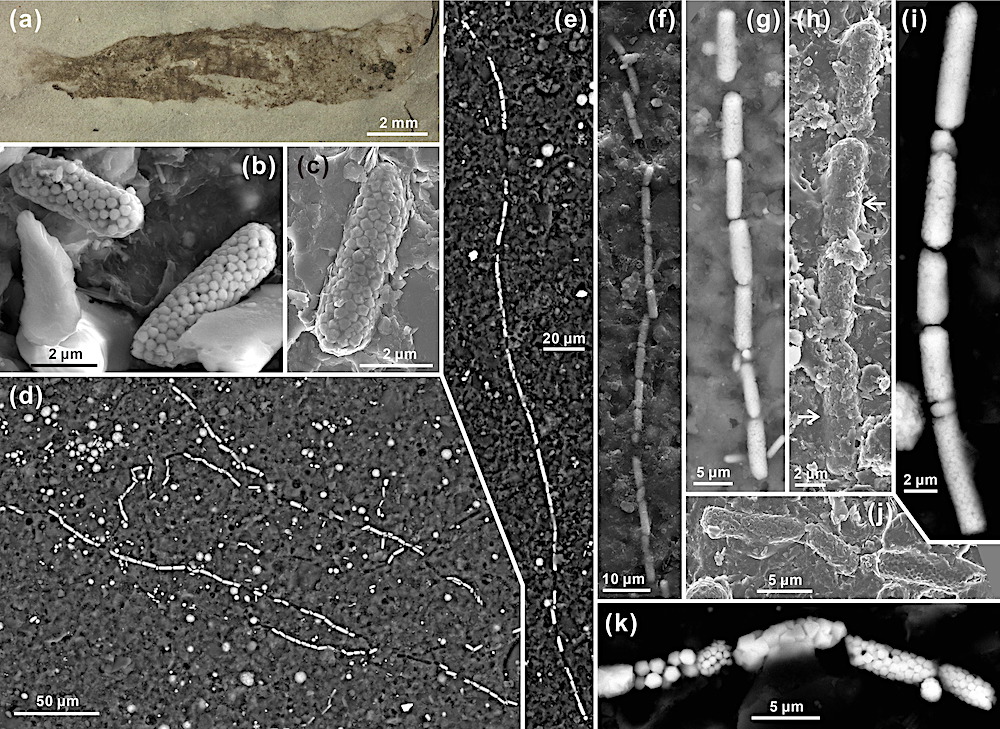
Qingjiangonema cambria from the Qingjiang biota. (a) Optical photograph of a soft-bodied macrofossil (specimen No. cy266) of unknown affinity, with abundant filamentous microfossils of Q. cambria (b–k) present on the surface. (b) SEM image of rod-shaped cells, photographed after acid maceration, showing equimorphic and equidimensional microcrystals within each cell. (c) SEM image, showing a cell embedded in claystone sediments. (d, e) Back-scattered electron microscopy (BSEM) images, showing multicellular filaments. (f) SEM image, showing a long filament consisting of numerous cells of consistent width and variable length; note the constrictions at cell junctions. (g) BSEM image showing a filament comprising cells with equivalent size and shape. (h) SEM image of a four-cell filament, showing elongated cells with a division groove at the mid length (arrows). (i) BSEM image of a filament composed of cells of variable length; note constrictions between neighboring cells. (j) SEM image showing a short filament embedded in claystone sediments. (k) BSEM image showing intracellular microcrystals that are equimorphic and equidimensional within each cell but variable among neighboring cells. — Science Bulletin
Overall, multiple lines of evidence including fossil morphology, living condition assessment and isotope analyses demonstrate that Qingjiangonema was a filamentous multicellular sulfate-reducing microfossil.
The discovery of this remarkable microfossil sheds light on the evolution of sulfate-reducing bacteria and cable bacteria. Phylogenomic and molecular clock analyses confirm an independent origin of multicellularity of Desulfonema and cable bacteria within the phylum Desulfobacterota.
More importantly, these molecular biological analyses infer that Desulfobacterota, encompassing majorities of sulfate-reducing taxa, diverged ~2.4 billion years ago during the Paleoproterozoic Great Oxygenation Event (GOE), while cable bacteria diverged ~0.56 billion years ago during or after Neoproterozoic Oxygenation Event.
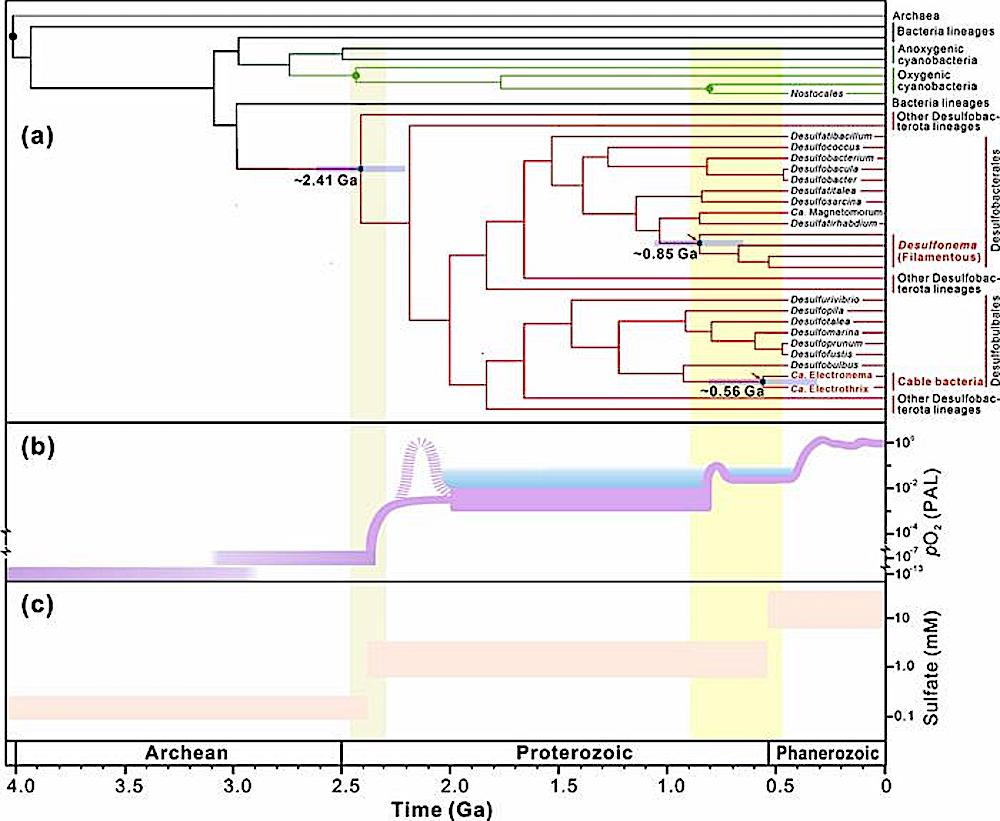
(a) Time tree of the major lineages of the phylum Desulfobacterota, with the sulfate-reducing Desulfonema and sulfide-oxidizing cable bacteria falling in two separate linages. (b) Evolution of Earth’s atmospheric oxygen content through time, PAL = present atmospheric level. (c) Simplified estimate for the history of seawater sulfate concentrations. Shaded areas crossing (a) to (c) represent time intervals of GOE and NOE, respectively, highlighting the coincidence between phylogenetic evolution of the sulfate-reducing bacteria and major increases of Earth’s atmospheric oxygen content as well as oceanic sulfate concentrations. — Science Bulletin
Taking together, the authors considered that Qingjiangonema cambria is either akin to Desulfonema or represents a sulfate-reducing ancestor to cable bacteria. They proposed that sulfate-reducing bacteria were firstly diversified in response to the increase of oceanic sulfate concentrations during the GOE and that sulfur-oxidizing cable bacteria evolved from a filamentous multicellular sulfate-reducing ancestor by reversal of the sulfate reduction pathway when large areas of the seafloor became oxygenated during or after the NOE.
The Cambrian microfossil Qingjiangonema reveals the co-evolution of sulfate-reducing bacteria and the oxygenation of Earth’s surface, Science Bulletin (open access)
Astrobiology





